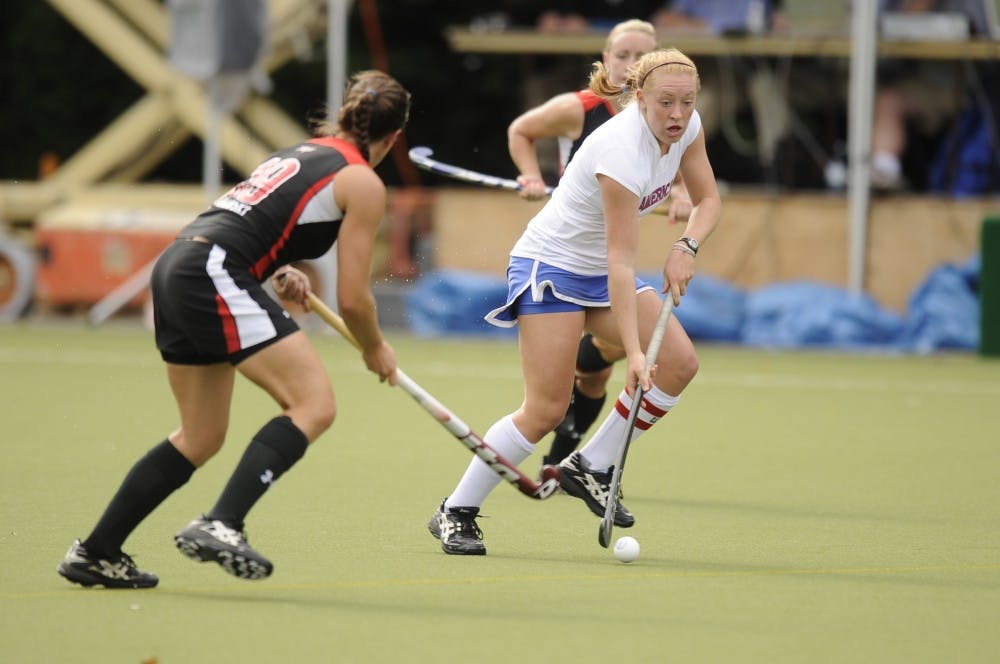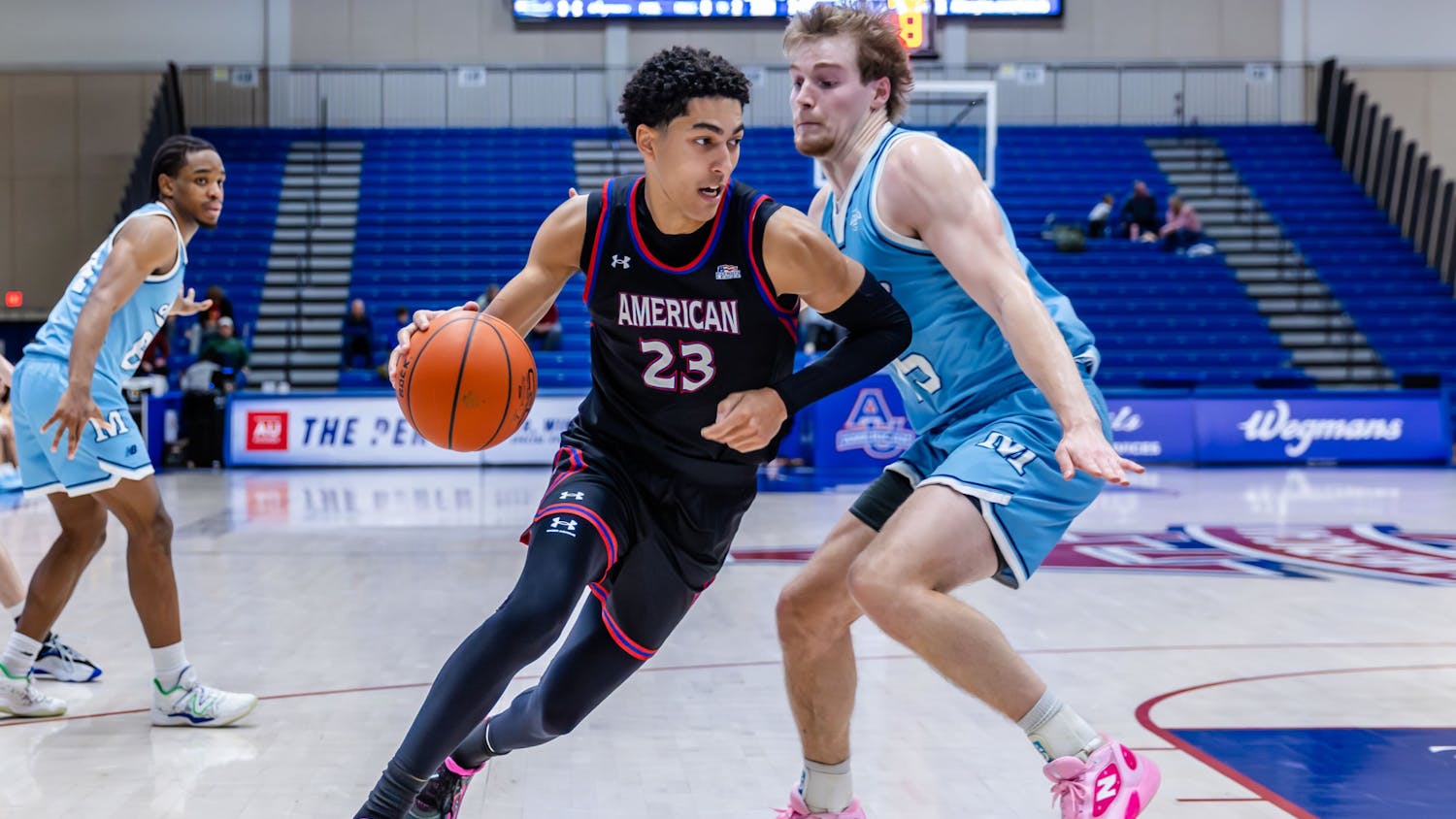Traveling down a track of ice head first 80 miles per hour is where AU alumna and U.S. Olympic skeleton hopeful Savannah Graybill feels the most control.
While Graybill only picked up the sport officially three years ago, she fondly recalls going down the sled head first as a child in Ephrata, Pa. because she got bored going feet first.
“I would definitely say I am up for anything that gets your heart racing,” said Graybill, a 2010 School of Communication graduate and former AU field hockey player.
Skeleton the sport
Skeleton is by no means a common sport, even for the Olympics after it was reinstated in 2002 after a 54-year absence. While it does not garner the attention of baseball or football, skeleton is usually only televised during the Olympics.
The sport involves speed and ice, a combination most would find dangerous. Skeleton requires a calm demeanor on the sled despite the potential dangers, according to Graybill’s coach Rebecca Sorensen. It is a skill Sorensen said potential competitors “have or do not have.” Graybill said skeleton was described to her as an “organized chaos.”
“When it’s a good ride it is very smooth and you feel like you are in rhythm with the track,” Graybill said. “When things aren’t going so well things can definitely not feel so good.”
“You can’t think about the things that could happen to you while you’re sliding, or the bad things will happen,” Graybill said.
From field hockey to skeleton
Graybill was raised by a family which valued physical activity, according to her mother Angela. Graybill and her twin brother Donald always played outside as children and have been competing since they were in the womb, Angela said. Savannah and Donald’s love of activities quickly transferred into a love of sport as Donald ultimately became an All-American in the decathlon while attending Shippensburg University in Pennsylvania.
There were very few sports Savannah did not pick up. By the time she reached high school Graybill actively participated on her varsity field hockey, basketball and track and field became captain of all three.
However, Graybill ultimately chose to stick with field hockey, attending AU and playing under head coach Steve Jennings.
“Savannah was a very powerful player for us on the forward line—she had a natural ability to score goals, was fearless in her approach to the position,” Jennings said in an email. “Off the field she is incredibly bright, serious but quick to laugh and is a person with tremendous passion.”
“Steve was very good at telling us to be comfortable with being uncomfortable,” Graybill said as her major takeaway from her time at AU. “It is just so applicable to everything you do in sport or in the real world.”
Graybill’s introduction to skeleton came when former AU strength and conditioning coach Jason Ridell received an email from Olympic medalist Elana Meyers inquiring if anyone was interested in joining the U.S. Bobsled team. After accepting the offer, Graybill travelled to Park City, Utah. She never competed with the U.S. bobsled team, but was invited to tryout with the skeleton team.
“Everyone was super supportive,” Graybill said about telling her friends and family about the move to the winter sport. Graybill admitted that when she first heard about the chance to participate in the sport, she was fully aware that she may not do well and end up taking a “real” job.
“It was exciting and was something that you know if it doesn’t work out, I’ll look for a job in the office,” Graybill said about her mentality when she was first asked to participate in the winter sport.
Training to be an Olympian
Most skeleton competitors do not have backgrounds in skeleton prior to joining, according to Graybill’s coach Rebecca Sorensen. The only commonality among sliders is “people who can move fast and like speed,” she said.
During the season, which lasts from October to April, Graybill will make roughly two runs down the track daily, five days a week. Sometimes, Graybill will slide for 20 days straight during team trials.
In addition to her physical preparation, Graybill must acquire the funds to be able to compete. With specialized equipment and fees for using the track plus travel expenses, competing in skeleton is an expensive venture. The sled alone costs $5,000, according to Graybill.
“When you first start the sport you don’t know the costs that athletes incur,” Graybill said. “You have to evaluate yourself every season; it is quite an expensive sport.”
Graybill said she and fellow teammates receive a stipend because they are part of the national team, but it does not come close to covering the costs. Most of her money comes from donations and summer work during the offseason, mainly waitressing.
Additionally, there are just 16 tracks in the world designed for skeleton, of which only two are located in the U.S. This means Graybill and her competitors receive limited reps on the course before sliding in competition and even fewer chances to practice on real courses.
However, the limited number of skeleton tracks has allowed Graybill to travel all over the world to compete. While the travel schedule can be hectic, she ultimately enjoys the opportunity and makes an attempt to take in the sites while she is traveling abroad.
During the offseason, none of the tracks are open due to the warm weather. Most of the training Graybill and her teammates undergo is sprinting and weightlifting. Competitors will rely on a push track, using a sled fixed with wheels, to simulate the push at the start of the race.
The busy schedule and funding issues have not deterred Graybill from success on the track. She won a silver medal at the National Championships in March and was named to the U.S women’s national team in November, putting her in a position to make the 2014 U.S. Olympic roster.
In order for Graybill to make the Olympics, her three-member intercontinental team must outrank another country in points, allowing the U.S. to qualify a third sled for the Olympics. Then one of the three members of the intercontinental team will be chosen for the final spot.
Despite the individual nature of the sports, Graybill said the relationship among her U.S. teammates is important. Even though each slider competes individually, there are team standings incentivizing teammates to establish good relationships with each other in hopes of finding success on the track.
For those who know Graybill well, the transition to skeleton would appear to be the next step in her history as an athlete.
The final stretch
Graybill has kept family and friends updated on her training through her blog, which has also become an outlet for fans, donors and supporters.
“I really like to put effort into that because I know that the individuals who are supporting me are putting an effort to support (my skeleton career),” Graybill said about her blog. “It’s just something I love to do and such a great way to keep everyone involved who is supporting my journey.”
Graybill cites the support of her family and friends as her main drive to succeed athletically, specifically her mother, Angela.
“We talk all the time,” Angela said about her communication with Savannah. “I want to know how things are going.”
Angela adds that she does not know many of the technical details of skeleton but makes an effort to keep Savannah focused on correcting any issues which may come up in her career.
Graybill does not know how long she sees herself as a participant in skeleton. Graybill says that prior to joining the skeleton team she had a five year plan, but has since grown to appreciate taking every day as it comes and not thinking too far ahead.
Even with her success and support Graybill acknowledges that her situation can be draining.
“I think she just keeps trying,” Angela says about what keeps her daughter motivated to perform at a high level. “She definitely has that persevering attitude, she is strong physically but she is strong mentally.”
Angela says that while there is a clear difference between Savannah as an athlete and a person, there are certain qualities which overlap.
“(Savannah) does have a fierceness to her as a competitor,” Angela says. “She is a fierce friend, she is a fierce sister and she has that tenacity as a person.”
Off the track, Savannah enjoys spending time with her friends and family. Even when she is away from skeleton, Graybill says she can’t shake the adrenaline bug, and will look for activities which get her heart racing.
If she does make the Olympic team, Graybill’s parents plan to do everything in their power to attend the Sochi Olympics.
For Graybill, reaching the Olympics would not only validate her hard work but would give her the chance to make her community of supporters, from friends and family to donors and fans, proud.




